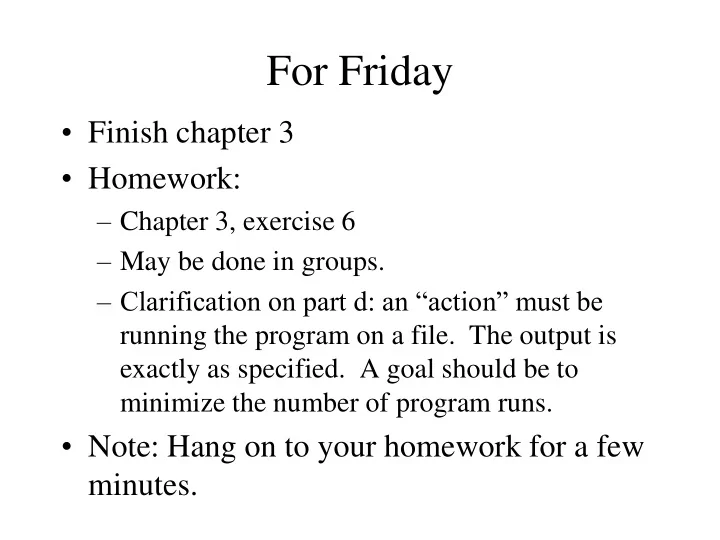

For Friday • Finish chapter 3 • Homework: – Chapter 3, exercise 6 – May be done in groups. – Clarification on part d: an “action” must be running the program on a file. The output is exactly as specified. A goal should be to minimize the number of program runs. • Note: Hang on to your homework for a few minutes.
Types of Agents • Simple Reflex • Model-based Reflex • Goal-based • Utility-based • Learning
Homework • Playing soccer • Exploring the subsurface oceans of Titan • Shopping for used AI books on the internet • Playing a tennis match • Practicing tennis against a wall • Performing a high jump • Knitting a sweater • Bidding on an item in an auction
Pathfinding
Solving Problems • Getting from the current state of the world to the state we want the world to be in. • May or may not matter how we get there.
Problem Formulation • States • Initial state • Actions • Transition model • Goal test • Path cost
Toy Problems • 8-puzzle • N-queens • Peg puzzle • Farmer, wolf, goat and cabbage • Missionaries and cannibals
More Realistic Problems • Route finding • Traveling Salesman Problem • VLSI layout • Robot navigation • Automatic assembly sequencing
Searching Concepts • A state can be expanded by generating all states that can be reached by applying a legal operator to the state • State space can also be defined by a successor function that returns all states produced by applying a single legal operator • A search tree is generated by generating search nodes by successively expanding states starting from the initial state as the root
Search Node Contents • May include – Corresponding state – Parent node – Operator applied to reach this node – Length of path from root to node (depth) – Path cost of path from initial state to node
General Search Function function General-Search( problem , strategy ) returns a solution, or failure initialize the search tree using the initial state of problem loop do if there are no candidates for expansion then return failure choose a leaf node for expansion according to strategy if the node contains a goal state then return the corresponding solution else expand the node and add the resulting nodes to the search tree end loop end
Implementing Search Algorithms • Maintain a list of unexpanded search nodes • By using different strategies for ordering the list of search nodes, we implement different searching strategies • Eg. breadth-first search is implemented using a queue and depth-first using a stack (as we’ll see soon)
Search Function Revisited function General-Search( problem , Queuing-Fn ) returns a solution, or failure nodes <- MakeQueue(Make-Node(Initial-State( problem ))) loop do if nodes is empty then return failure node <- Remove-Front( nodes ) if Goal-Test( problem ) applied to State( node ) succeeds then return the corresponding solution else nodes <- Queuing-Fn( nodes , Expand( node , Operators( problem ))) end loop end
Properties of Search Strategies • Completeness • Time Complexity • Space Complexity • Optimality
Two Types of Search • Uninformed Search – Also called blind, exhaustive or brute-force – Make use of no information about the problem – May be quite inefficient • Informed Search – Also called heuristic or intelligent – Uses information about the problem to guide the search – Usually guesses the distance to a goal state – Not always possible
Breadth-First Search • List ordering is a queue • All nodes at a particular depth are expanded before any below them • How does BFS perform? – Completeness – Optimality
Complexity of BFS • Branching Factor • For branching factor b and solution at depth d in the tree (i.e. the path-length of the solution is d) – Time required is: 1 + b + b 2 + b 3 + … b d – Space required is at least b d • May be highly impractical • Note that ALL of the uninformed search strategies require exponential time
Uniform Cost Search • Similar to breadth first, but takes path cost into account
Depth First Search • How does depth first search operate? • How would we implement it? • Performance: – Completeness – Optimality – Space Complexity – Time Complexity
Comparing DFS and BFS • When might we prefer DFS? • When might we prefer BFS?
Recommend
More recommend